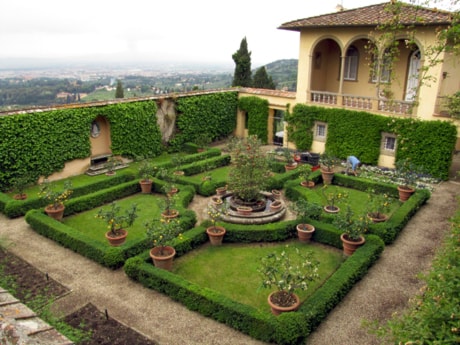Visiting a European garden is a holiday within a holiday.
Their centuries-old beauty provides abundant relief from traffic, noise and heat.
Many cities boast free or low admission public gardens only a short walk or transit ride from major tourist attractions. Or you can go online before departure to find private gardens accessible with a simple appointment.
While France’s famous Versailles garden outside Paris is an 800-hectare horticultural triumph, its beauty can be offset by the nearly six million tourists who visit it annually. Opting for smaller, less frequented Parisian spaces is a reward of its own.
The lovely Jardin de Cluny fits that bill. The 1.2-acre Latin Quarter decade-old garden is based on its medieval predecessor and inspired by the 15th century Cluny Abbey museum’s medieval collections. It boasts an inner courtyard with vegetable and medicine plots, rows of aromatic roses, fountain and children’s glade. A “forest” surrounds to screen out the noisy Boulevard Saint-Germain as Sorbonne and other université students picnic within.
There’s little noise in the Jardin de Luxembourg despite the numbers who flock to it. More park than garden, its 54 acres feature the Luxembourg Palace, large octagonal pond and gravel lanes encircled by statues. Children enjoy pony rides, a puppet theatre, carousel and playground.
But the Fontaine de Medicis, a baroque fountain designed in 1624, is the star here. Annuals and perennials framed by flowering trees and shrubs lead to it from back. The front reveals Polyphemus of Greek mythology watching lovers Acis and Galatea spilling water to a quiet pond. The fountain was built by resident Marie de’ Medici to remind her of growing up in Florence’s Pitti Palace.
The Boboli gardens’ sprawling elegance graced her childhood. Started by her grandfather Cosimo in 1550 and expanded further by her father Francesco and later Tuscan grand dukes, it’s evolved over 400 years into a modern Italian horticultural gem.
Radiating 11 acres around Boboli Hill’s peak where a rose garden borders the Porcelain Museum and grand alleys wind through cypress, plane and other Mediterranean trees.
Annual and perennial plots and lawns are offset by Italian masters’ sculptures (originals now replaced by replicas). Highlights include Isolotto’s Basin plus two other fountains and an amphitheatre with authentic Egyptian obelisk and Roman sculpture the Medici brought from Rome.
Get there across the medieval Ponte Vecchio and window shop its world famous jewelery stores. Visit the Pitti Palace for modern art, Palatine and costume galleries as well as opulent royal apartments. A garden picnic with trattoria or groceria offerings rounds out a perfect Tuscan day.
The Medicis — who else? — established Orto Botanica, now a two-acre Firenze University research space. This oasis boasts fragrant roses (one dated to1590) and enormous irises framing a circular fountain beneath a canopy of global tree imports, some centuries old.
An herb garden with unusual basil, rosemary and mint varieties face tropical greenhouses, one housing an amorphophallus titanum, the enormous Sumatran flower whose triennial blossom reeks of rotting flesh. About $8 each buys a bit of priceless tranquility amid Florence’s striking and enjoyable bustle. It’s only blocks from the Galleria dell’Accademia where the masterpiece David towers above five other Michelangelo sculptures.
Overlooking Florence’s Arno River valley lies Fiesole’s villas and gardens. Olive groves give way to flowered terraces on the short bus ride up. The city’s hillcrest streets yield private gardens of astonishing skill and care. Beyond is Florence’s architecture — Duomo, church towers and palaces dotted with piazzas — breathtakingly backed by Tuscany’s slopes. Tours are available with online bookings and vary in price and duration.
Book your own visit to the stunning Villa Le Balze (The Cliffs). The Georgetown University study centre was originally a home to American philosopher Charles Augustus Strong, husband of John D. Rockefeller’s daughter Elizabeth.
He commissioned Britons Cecil Pensent and Geoffrey Scott to design the house and gardens in 1912. They moved more than 1,000 tonnes of earth to sculpt terraces and install an ingenious water conservation system to slake dry Italian summers.
There are two main buildings, seven formal gardens and an olive grove. Frescos and mosaics made of seashells and coral adorn a dual grand staircase surrounding a grotto fountain. Topiary, shrubbery, tree bowers and lanes outline gardens of perennials and annuals. The many roses and gardenias utterly perfume the property. Bookings can be made onine at www11.georgetown.edu/oip/os/villalebalze.
Cologne’s public botanic garden proves German prowess and precision. The Flora und Botanischer Garten Köln began in 1863 when the city contracted creation of a (now 28 acres) flora park to replace one demolished for the central railway station’s construction. The Italian Renaissance and English design styles amaze with numerous water features, bowers and flowers. Flourishing in four greenhouses are rainforest varieties and cacti.
Walk amid the nearby Sculpture Park’s 40 modern bewitching and bewildering pieces. The artists’ themes and styles range from whimsical to macabre, idiotic to intelligent. Like the botanical garden, it’s great fun and free.
The Cologne Zoo between the two is a terrific stop for any family. Get to them all by walking the Rhine River promenade to and from the Cathedral.
